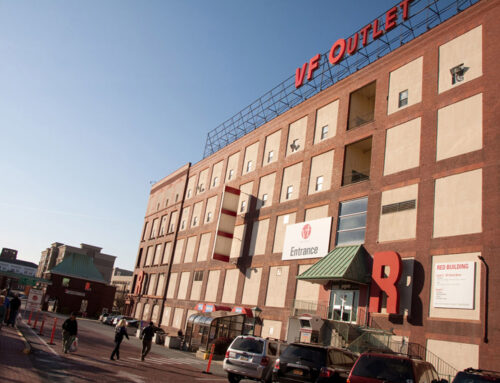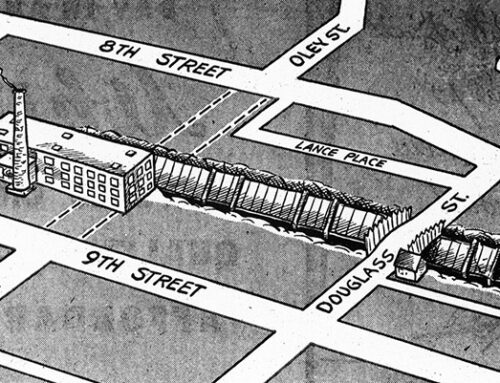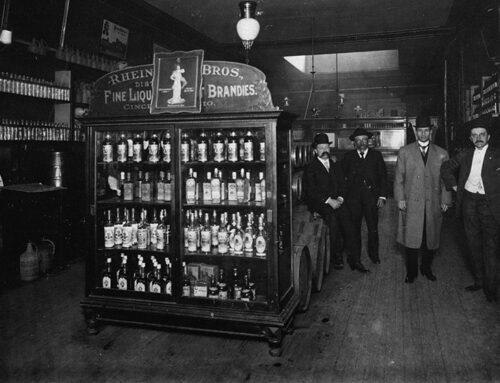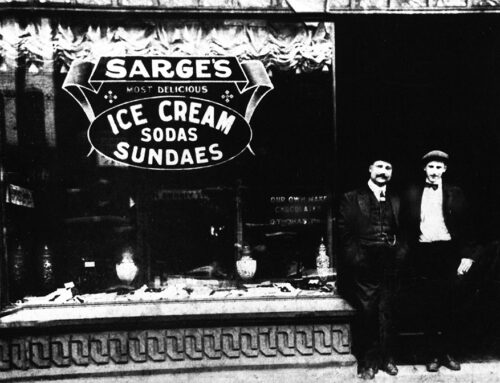Outlets first appeared in the Eastern United States in the 1930s. Factory stores started to offer damaged or excess goods to employees at a low price. After some time, the audience expanded to include non-employees. In 1936, Anderson-Little (a men’s clothing brand) opened an outlet store independent of its existing factories. Until the 1970s, the primary purpose of outlet stores was to dispose of excess or damaged goods. By the 1970s Reading was enjoying its new status as the “outlet capital of the world.” Tourists began flocking to Reading in search of bargains, filling once empty hotels and motels.
Before it became the outlet capital of the world, Reading was a red-brick factory town situated in the rolling Pennsylvania Dutch countryside. Long an apparel-manufacturing center, it lost several of its leading businesses to the South. In the 1970s chartered buses with license tags from New York, Ohio and New Jersey began to fill the narrow streets of Reading’s outlet district. Vacationing families from New England, New York, Indiana and other states were carrying bundles of back-to-school garments under their arms and smiles on their faces.

At one time Reading was dominated by textile manufacturers. By the 1960s and early 1970s most of the textile companies moved south, but a couple that remained – Talbott and David Crystal – had outlets, mainly for women’s clothing. Under the leadership of Kitty Solomon, the Berks County Pennsylvania Dutch Travel Association turned to tourism to increase area earnings. Arguing that outlet shopping could be a major attraction, she convinced the V.F. Outlet, Great Factory Store, Talbots, and David Crystal to join the association, and helped establish itineraries for tour brokers to stop at the outlets. The association distributed a brochure to bus companies, as well as nearby social groups, travel organizations, and clubs. The response was overwhelming. The Reading outlets became a favorite bus-trip destination. Buses with plates denoting they’ve driven from New Jersey, Connecticut, Virginia, Maryland, New York, Ohio, and the District of Colombia nestled into parking lots the size of football stadiums beside cars from every state in the union. The association made reservations for meals and lodging and provided tour guides for the visiting buses.
The Chamber of Commerce and the Berks County Travel Association began actively promoting Reading as the “outlet capital of America.” A billboard on U.S. 222, about 10 miles from Reading, read “Catch Outlet Fever.”
The next thing anybody knew, groups began arriving on “outlet outings.” They came on buses from as far away as Canada. And the groups kept coming, particularly on Saturdays. Their buses took them from one outlet center to another. Roger Rachman, head of the company that operated the Great Factory Store outlet center, estimated that more than a million out-of-town shoppers visited Reading in 1977.
In the early 1970s there were only a few well-known Reading manufacturers who sold their excess merchandise, canceled orders and irregulars. Mrs. Solomon’s association grew from an initial 11 outlets to 68 outlets in 1981. Among them were Vanity Fair, a maker of women’s lingerie, and David Crystal, which made shirts with the tiny over-the-heart alligator.

Where there were empty factory buildings deteriorating and blighting the neighborhoods, there were now thriving shops and restaurants. Outlets began relocating from other areas to get in where the action was. Older outlets expanded. The four original outlets were David Crystal, Vanity Fair, the Great Factory Store and Talbotts.
Before they were outlets, the Great Factory Store was a complex of small manufacturers. The Reading Outlet Center used to be a hosiery manufacturing company. Vanity Fair was a 5,000-square-foot area separated from the factory by a large drop cloth. The VF Outlet Center expanded over the years by attracting other outlet retailers to the 34-acre site, which straddled the border between the boroughs of Wyomissing and West Reading.
In 1970, M.O. Lee, then-president of VF Corp., suggested holding a sale one Saturday morning at the company’s Berkshire Knitting Mill in Wyomissing to get rid of excess Berkshire International inventory. The sale was a smashing success, so a bigger sale was scheduled for two weeks later. That one was an even bigger hit. As a result, a factory store was opened to sell Berkshire and Vanity Fair surplus products. The factory store eventually grew to an outlet center – the first of its kind in the country.
Below: Image Gallery – VF Outlet Center – Touch or Click Images to Enlarge.
In 1973, Ship ‘n’ Shore was bobbing along with a cut-and-sell operation in a creaky hosiery mill in the 800 block of Moss Street. Someone figured how to move mistakes and excess inventory by turning a 10,000 square-foot vacant area in the building into an outlet store. Word got around and the 800 block of Moss Street, along with the Great Factory Store, skyrocketed into the retail mecca dubbed the Moss Street outlets.
The Great Factory Store, located in the 1100 block of Moss Street, was home to some of the city’s premiere knitting and apparel mills, including the Chancellor Hosiery Wills, David Crystal Inc. dresses, Gail Knitting Mills, Rachman Manufacturing Inc., M&M Knitting Mills Inc., Berks Sportswear, I. Sherry Co., E. Schulze and Sons hosiery dyers and the sprawling DS&W Hosiery Co., which was housed in buildings on both sides of Moss Street. Manufacturers sent their overruns, cancellation orders and out-of-season stock to their outlets where the merchandise was sold for about 50 per cent off retail.
Below: Image Gallery – Great Factory Store – Touch or Click Images to Enlarge.
Before the outlets the standard tourist attractions were the Kutztown Pennsylvania Dutch festival, the Daniel Boone homestead and a dozen campsites. Not everybody likes historic sites. But everybody likes a bargain and everybody likes to shop.
The “Catch Outlet Fever” became a disease that bargain hunters couldn’t resist. With factory outlet stores offering discounts of 30-70 percent on everything from clothing, toboggans, power drills, pretzels, Christmas ornaments and luggage, the old brick town attracted shoppers from as far away as North Carolina, Massachusetts and Ohio.
New restaurants opened to serve the shopping crowds. Hotels and motels that once were filled only with the weekday businessman trade were now booked on weekends too. And some buses stopped at the Berkshire Mall, the city’s major new shopping center.
The seasoned shopper parked in the purple section, in front of Reading’s China and Glass outlet, for quick trunk trips to dump packages and for easy access to VF’s three big beauties – Blue, Red, and Purple. Men shopped in the Big Blue and women in the Big Red. Racks and racks of nylon slips clustered in beiges, whites, and occasional blacks and pinks filled part of the auditorium-sized room. The next room exploded into combinations of cotton briefs of sherbet pastels. After stocking up on basics, the shopper hit Blue’s third floor, the showcase for brand-name specialty shops like Laura Ashley, L.L. Bean, Canterbury of New Zealand and Cambridge Dry Goods. Other good bets were Carter’s, where savings hovered around 25 percent on everything from infants’ stretchies to jeans skirts; Reading China and Glass for discounted microware, dishes, and Farberware pots and pans; as well as Black and Decker, where the tools, toaster ovens and lawn mowers were labeled “blemished” for imperfections that ranged from a scratch to a reconditioned part.
Shoppers need nourishment and some of the outlet centers thoughtfully provided it. The VF complex had a basement cafeteria in the main building that serves typical lunch food in an atmosphere reminiscent of a high school cafeteria. Reading China & Glass had a bakery counter in the store, where you could grab a muffin or pause for a cookie break. Reading’s Big Mill outlet center featured a food court.
Before heading for the heart of Reading, some stopped by the Danskin outlet, a few blocks from VF’s entrance, for the half-price savings on children’s leotards, tights and beribboned crinoline skirts. Others swung by Hiesters Lane on the edge of town or the David Crystal outlet, the granddaddy of all Reading outlets, at 13th Street and Rosemont Boulevard. Here you’d find Izod Lacoste sportswear for men, women and children.
The shopper who could still stand made the trek to Reading to stop by the Reading Outlet Center, a tired-looking former factory whose stores were cut into somewhat confusing labyrinths of dead-end halls and narrow staircases. The Reading Outlet Center opened in 1973 in a cluster of five former factory buildings. In 1984, the center was acquired by Charles T. McMurtrie, who doubled the center to 10 buildings.
Below: Image Gallery – Reading Outlet Center, Building no. 1 – Touch or Click Images to Enlarge.
In 1986 Reading’s centers lured more than 4 million shoppers who spent $340 million. The tourists, the pennywise, and the trendy came seeking the promise of cut-rate goodies. The prices were so good that the seasoned shoppers bought many of the same items even if they didn’t need that many. During the holiday shopping marathon, up to 300 busloads of discount-seekers descended on Reading on a Saturday. In 1989 more than 300 outlet stores in six complexes in and around Reading attracted more than 6 million visitors a year. Shoppers spent $250 per visit and outlet revenues were $975 million.
The outlet industry reached maturity in the late 1990s. Imitations began springing up all over the country, turning outlets into a major retail industry. The number of outlet centers nationwide leaped from 142 in 1988 to 329 in 1996. By 2005 the number of outlet malls sagged to 225.
In 1991, Reading was officially named the “Outlet Capital of the World.” The phrase was registered with the U.S. Patent & Trademark Office.
In 1996 a three alarm arson fire, out of control for more than four hours, destroyed the former Great Factory Store in the 1100 block of Moss Street. The building was vacant since July 1985.
Below: Great Factory Store Fire.
After thriving for years with 70 stores, the Reading Outlet Center had fallen on hard times. By 2002, only 20 stores remained. Tour bus traffic trickled in at the rate of about 10 to 20 buses per weekend, compared with about 100 at the center’s peak. By 2004, Reading Outlet Center was down to one tenant, Old Navy.
In 2001, the VF Outlet Center was still getting an estimated 5 million visitors a year. That year it was voted the top U.S. shopping destination by the American Bus Association, with about 6,000 buses traveling to the center in a year. With more outlet centers opening in other places the VF Outlet Center became less of a regional draw. In December 2016, with only about a third of its retail space leased, the VF Outlet Center was sold to Equus Capital Partners. Constructed in the early 20th century, the site started as the home of the Berkshire Knitting Mills, which employed thousands of people. At its peak, from the 1920s through the 1950s, it made more women’s full-fashioned stockings than any other plant in the world. The knitting mills and related textile operations formed the backbone of the early development of Wyomissing, which has since become a regional hub of business activity. The borough still thrives long after it ceased to be a center of industry.
Below: Berkshire Knitting Mills.

In 2016 the Shuman Development Group completed converting the former Reading Outlet Center building no. 10 at 702 N. Eighth St. into a retail and apartment building. The building, listed on the National Register of Historic Places, was opened in 1904 as the Curtis, Jones & Co. shoe factory.
It was then used as part of the Reading Outlet Center from 1974 to 2001. When redevelopment was 65% complete, a two alarm arson fire occurred on October 18, 2014, severely damaging the 2nd and 6th floors, and roof. The fire damaged fabric was removed, the structural system was reevaluated, and the project was completed in December 15, 2016.
Below: Curtis, Jones & Co. Shoe Factory.

In October 2017 developer Alan W. Shuman was issued a permit by the city to begin the demolition and redevelopment of the building known as Reading Outlet Center One at 801 N. Ninth St. The rundown interior of the massive structure at 801 N. Ninth St. is rich in history. The original owner, Nolde & Horst Co., started making hosiery there around the start of the 20th century.

Nolde & Horst Co.
Nolde & Horst went out of business around 1954. The total demolition and renovation project included demolishing the northeast section and the entire stretch along North Ninth Street. The redevelopment plan included 80,000 square feet of retail space. The $12 million project also included 110 parking spaces and two retail pad sites. The redevelopment plan was later abandoned by Alan W. Shuman. On February 8, 2018, a blast of dynamite forever changed the skyline of Reading’s old outlet district. The 135-foot tall smokestack that towered above the site of the former Reading Outlet Center One and the North Ninth Street neighborhood for decades came tumbling down in a matter of seconds The entire building was demolished and the plan abandoned.
Below: Remains of former Reading Outlet Building no. 1.
In December 2016, Equus Capital Partners Ltd of Philadelphia bought the former VF Outlet Center, which included the Designers Place building. In November 2017, work began on a $70 million plan to transform the VF Outlet Center into a 34-acre mixed-use retail and business campus with UGI Energy Services as the anchor tenant. Tower Health said it plans to move into an additional building on the campus. Other businesses include Orthopedic Associates of Reading and Sly Fox Brewing Co., based in Pottstown. Redevelopment plans included the demolition of approximately two-thirds of what is known as the Blue Building and all of the Red Building.
In May 2018, VF Outlet relocated to the former Designers Place building.

In July 2019, UGI Energy Services began the process of relocating its headquarters and about two-thirds of its 250 employees from Spring Township to VF Outlet’s former Blue Building.
Below: UGI Energy Services building.

In July 2019, Tower Health of West Reading and Drexel University on Monday marked the start of construction on a four-year regional medical school in Wyomissing that would serve 200 students. The 150,000-square-foot-campus on Parcel 9 of the Knitting Mills redevelopment project should be finished by April 2021.
Below: Architectural rendering of Drexel University College of Medicine at Tower Health.

Drexel University College of Medicine at Tower Health

Mrs. Estelle Angelini peered out the window of the sleek gray bus.
It was just before 9 a.m. on a Thursday and the traffic into her native Philadelphia was stretching in serpentine lines for miles along the opposite side of the Schuylkill Expressway.
As the bus rolled gently atop the well-known contour of the expressway, Mrs. Angelini looked at the Philadelphia-bound snarl and smiled a knowing smile. She was going shopping.
But not on the crowded, noisy streets of Philadelphia. She was headed for Reading to participate in one of the favorite pastimes of thousands of east-coast housewives – outlet shopping.
“Why should I have to put up with the traffic and the population and still pay high prices? I can hop on a bus, come to Reading find some real bargains and have a nice lunch,” said Mrs. Angelini while fingering through a pile of sheer lingerie at the Vanity Fair outlet in Wyomissing.
The old textile factories of Reading and its environs have become a shopper’s mecca.
Scores of chartered buses enter the city daily for stops at VF, Talbott, Cousins, David Crystal, ArKay, and the Moss Street stores. Most of the excursions include a luncheon stop at a local eatery like the picturesque Stokesay Castle.
Travel agencies in Philadelphia and in cities like New York, Baltimore and Washington D.C. have recognized the popularity of outlet shopping and have established regular weekly (and often more often) tours to Reading.
The average cost of a trip to Reading from Philadelphia including round trip bus fare (with stops at five or six outlet stores) and a lunch is about $15.
“These trips are great fun,” said Mrs. Angelini. “The girls in the neighborhood usually get together for a trip about once every few months.”
“It’s a great way to get your shopping done and still have a great time. The cost of the trip is made up in the savings on the clothes,” she added.
As might be expected, the outlet store concept is also quite popular with the stores.
“It’s a quick, easy way to get rid of overruns (oversupply of items) and discontinued styles,” said Vanity Fair (VF) outlet store manager Thomas Lucas.
“We sell both first-class merchandise and irregulars. Everything is 50 per cent off the price tag list,” he noted.
Most of the many factories in the area had their own factory stores but for years those stores were ignored and left to the families of employees.
But suddenly the outlet stores have become very big business – for the stores and for the city.
“I really think that outlet stores are one of the biggest things Reading has going for it,” said Mayor Eugene L. Shirk.
“I am amazed at the number of buses I often see parked in the lots of the stores. And whenever I travel people are always asking about Reading’s outlet stores,” he said.
The area between Reading and Lancaster has always been a popular tourist attraction and now the outlet stores are cashing in on that popularity.
“We were passing through the area and I wanted to see some of the Pennsylvania Dutch things. Then I remembered about the outlet stores and I figured that since I’m getting married soon I might as well get some shopping done,” giggled Julie Miller of Hackensack, N.J.
“I’ve never seen such a collection of robes and nightgowns,” said Mrs. Angelini while making the rounds in VF’s store.
“And it’s all beautiful stuff.” The first time I came here I wasn’t aware that everything was half-price. But I liked the things so much I was more than willing to pay the whole thing,” she said.
Many of the buses make what is known as the “Wardrobe Tour.” They will stop at VF for lingerie, then move onto Talbott’s, Cousins, and David Crystal for dresses and pantsuits, and anyone of several shoe outlets for footwear.
Although the outlet tours are usually filled with women, the discount shopping is by no means limited to one sex. There are quite a few men’s outlets in Reading and all of the major factories have portions of the stores set aside for men’s furnishings. There are even stores that specialize in golf clothing.
Service station operators in the vicinity of outlets are getting so tired of giving directions to out-of-town bargain hunters that many have now placed signs in their windows like “David Crystal – next light” or “Take a left for VF.”
But the way things are going with the outlet craze, it won’t be long before signs are passé and Reading’s nickname changes from Pretzel City to Outlet City.
In 1991, Reading was officially named the “Outlet Capital of the World.” Read more about the “Outlet Capital of the World – Discount Mecca of the East.”






















Leave A Comment